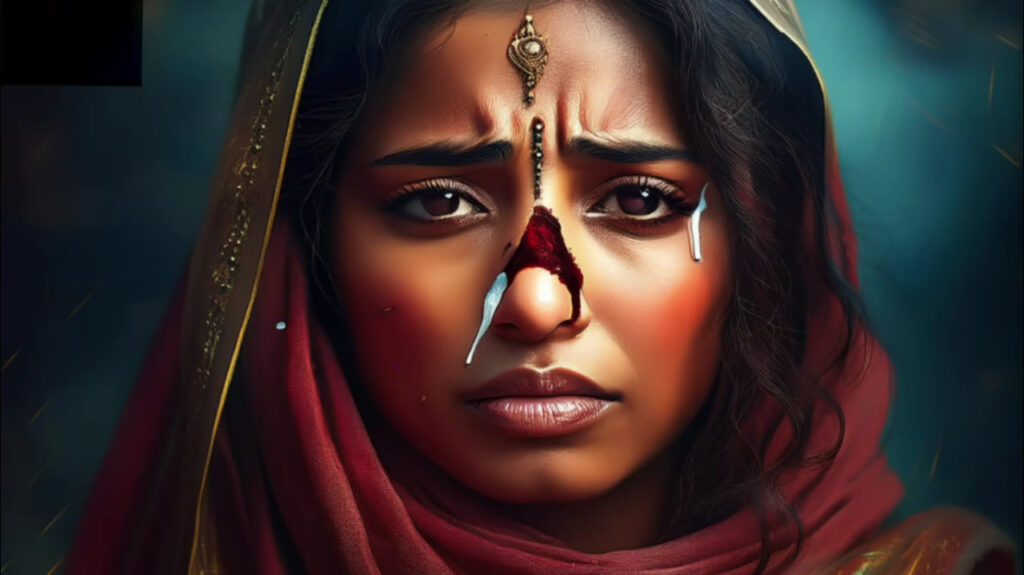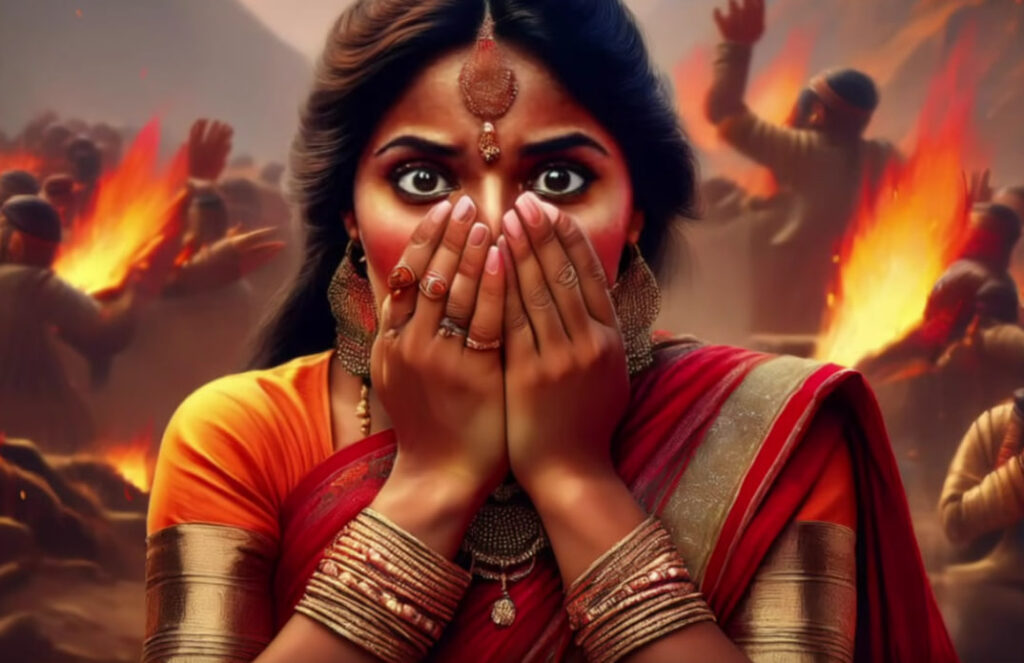I’m bringing four incidents that clearly show what kind of horrific crimes were committed against women in Indian history. Each incident reveals a new type of violence against women—burning them, cutting their noses, kidnapping them, forcing them, and so on. Behind every form of violence, there’s an interesting kind of misogyny, and that’s what we’ll look at today.

Event 1: A Cruel Act by Veer Rajendra Chola (11th Century) Violence Against Women
Around the 11th century, King Veer Rajendra Chola I fought a war against the Chalukya kingdom. The Chalukya king, Someshwara I, sent an army led by his general, Samundra Raja, to attack Chola land. Veer Rajendra won the battle, killed Samundra Raja, and cut off his head. But he didn’t stop there. He also cut off the nose of Samundra Raja’s daughter, Nagla.
An old writing from that time says Nagla was as beautiful as a peacock. So why was her nose cut off? She wasn’t even part of this war. Veer Rajendra, the so-called brave warrior, ruined something so perfect. Of course, he was dancing after cutting the nose of an innocent girl who wasn’t trained for war. Why was this shameful mark given to Nagla? It was a mark to disgrace her community, Veer Rajendra’s enemy’s community, because women were seen as the honor of a community. Disgracing them meant disgracing the community. This disgusting thinking and violence against women was very common in patriarchal society and still is. In fact, this happened openly, and it happened often to women, as our next example shows.
Event 2: Raja Kesari Varman’s Attack in Sri Lanka (1046)
The second incident also comes from an inscription. Raja Kesari Varman, also known as Rajadhiraja Chola, the grandson of Rajaraja Chola and son of Rajendra Chola, attacked the Pandya king Veer Salmagan in Sri Lanka in the 29th year of his reign, in 1046 CE. But Veer Salmagan, following the long, tiring tradition of Hindu kings running from the battlefield, fled after losing. Anyway, Rajadhiraja kidnapped Veer Salmagan’s elder sister and daughter and cut off his mother’s nose.
The inscription says Veer Salmagan returned to the battlefield to take revenge for this disgrace, but this time he had to lose again. This is also a praise inscription on the walls of the Rajagopal Perumal Temple in Mani Mangalam, Tamil Nadu, which grants land to the temple. This inscription makes our job easier by showing that people saw kidnapping a family’s sister or daughter and cutting off a nose as a disgrace. It wasn’t called an inhumane act—it was called an act of disgrace, meaning the shame was placed on the family for what happened to their girls, not on the ones who did it. The shame is on the daughter, the mother, the sister, but not on the one who did this shameful act.
The inscription calls him a great warrior. Rajadhiraja, the great king, not a criminal. The inscription also makes it clear that Veer Salmagan came back not for his sister, daughter, or mother but to take revenge for his own honor. If he cared about his mother, daughter, or sister, he would’ve taken them when he was fleeing. Like the first time, this time too, Veer Salmagan’s mother, daughter, and sister were not part of the war.
Women as War Trophies: The Chola Kings’ Dark Legacy
Why do I keep saying this? If they were part of the war, would cutting their noses be okay? No, it would still be wrong. But in wars, those fighting often attack each other extremely, and that’s understandable, even if not always justifiable. But capturing and torturing civilians who were never part of the war is just perverse. Interestingly, Rajadhiraja didn’t cut the noses of the daughter and sister; he kidnapped them. Only the mother’s nose was cut. Why?
According to Daud Ali, Chola kings who won wars often kidnapped women from the enemy camp. Chola kings took these women from the battlefield—some had their noses cut, while others were made part of the Chola vadam, where female slaves of the royal household lived. This slavery could be domestic, where they did palace work, or sexual, physical. Why only women? Both inscriptions talk about women and their noses as a prize, sadly mentioned in glorified words. Did this ever happen to a king’s brother, son, father, uncle, or neighbor? The answer comes from our third incident.
Event 3: Manusmriti and Rules That Allowed Violence against Women
When we talk about violence against women, how can Manu Ji of the Manusmriti not come up? Come on, Manu Ji, because only you can give approval to the worst crimes and violence against women. Kidnapping women by force, making them slaves for domestic or sexual work, cutting their noses—all this was approved by two verses in the Manusmriti. The first is in Chapter 3, which lists types of marriages. Eight types are listed.
The first four—Brahma, Daiva, Arsha, and Prajapati—are considered the best forms, recommended for Brahmins and legal. The last four are very interesting. Gandharva is basically a love marriage where a man and woman choose each other willingly. Then Asura, where instead of taking dowry, the woman’s family is paid a bride price. Then Rakshasa, violently kidnapping a woman from her home, even if she’s crying or screaming, with destruction all around. And lastly, Paishacha, secretly forcing sex on a woman when she’s asleep, drunk, or not mentally sound.
Approval of Forced Marriage
How are these forms of marriage? Surprisingly, Manu Ji agrees. But two of these bottom four marriages are allowed for Kshatriyas, in Chapter 3, verse 26. Take a guess which ones: Gandharva, the voluntary love marriage, and Rakshasa, kidnapping a woman by force even if she’s crying or screaming. According to the Manusmriti, this is a valid marriage. Let that sink in, guys. Why pretend to respect women? Obviously, Kshatriya kings and warriors would force women in battlefields. The legal book gave them approval, calling it lawful. Forcing women is lawful? How do you live with yourself, man?
That’s why Chola rulers who forced women weren’t called criminals but brave kings. Society’s laws say, “Do it, do it, you’re so brave!” And that’s not enough. There’s another verse in Chapter 7, verse 96, in the Manusmriti that says the winner in a battlefield can take the loser’s chariots, elephants, horses, umbrellas, money, grains, animals, and women. If a soldier loots these, he must give a portion to the king. There you have it—legalized violence against women on the battlefield. The list is interesting too, with women listed alongside animals, outright objectifying women as if they’re just things to be won in war. And with this, the Manusmriti wins our misogyny award. Truly, there are many more verses against women in the Manusmriti.
Women were clearly scared of being looted in battlefields, obviously. But women being looted was seen as shameful for their family or kingdom, a disgrace. To prevent this looting, they advised their own women to die after losing, instead of legally stopping the looting of women. Men couldn’t control themselves. They’re men, boys will be boys, they’ll loot anyway. If you want to escape it, that’s proven by our fourth incident.

Event 4: Jauhar in the 12th Century
This story is from Kalhana’s book Rajatarangini, Chapter 7, verses 1548 to 1580. It happened in the year 1101 CE. At that time, King Uchchala attacked King Harsha’s kingdom—especially the city of Srinagar. By the way, King Harsha was one of the biggest temple-destroying kings in India.
Now, let’s come back to the story. King Uchchala attacked King Harsha’s Kingdom. Uchchala was Harsha’s relative. He was jealous of Harsha’s son, Bhoja, and didn’t want him to become the next king. So, with the help of his feudal lords, called Damaras Uchchala attacked Harsha.
When Uchchala’s army reached Srinagar, many women died. Harsha’s queens, to avoid being captured, ran to a four-pillared courtyard in the palace and set fire to it. Verse 1571 of the book says that they did this out of fear of Uchchala’s army.
Verse 1578 tells us that Uchchala’s Damaras were everywhere, kidnapping women from the palace. Kalhana compares these women to fairies. To avoid this, in verse 1579, it is written that Queen Vasantha Lekha and 17 other women—including Harsha’s daughters-in-law—burned themselves alive.
The Truth About Jauhar: A Painful Practice Before Muslim Invasions
This act is called Jauhar. But many people wrongly believe that Jauhar only started when Muslim (Turkic) kings came to India in the 1200s. This story clearly shows that Jauhar happened before that and even during Hindu vs. Hindu battles. There were no Muslim kings in this story—only Hindu kings and soldiers.
Women were taught that their “honor” was more important than their life. So, they were told to die instead of letting any man from another family touch them. That’s why many women burned themselves alive. Today, some people still call this a brave act. But it was a terrible and painful thing. Instead of respecting the women, we should question the kings and warriors who created such fear that women had to do this.
The Jauhar during Harsha’s time is one of the earliest recorded cases in Indian history. Once again, like in many other battles, women—who had no role in the war—suffered the most.
Final Words
It’s believed that in Hindu versus Hindu fights, women were respected, and they were taken from battlefields to protect them. It’s kind of sad, it makes me laugh, but it’s solidly tragicomic. In Hindu versus Hindu fights, women’s noses were cut, they were kidnapped and made slaves, or taught to burn themselves, instead of stopping their looting. Their looting was justified in legal texts like the Manusmriti. My purpose here isn’t to show any religion as high or low. My purpose is just that you understand how horrible crimes against women happened in Indian history, and anyone who tries to hide or minimize them, their history will surely be exposed.